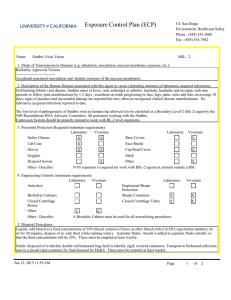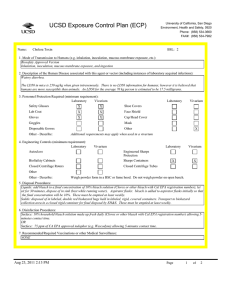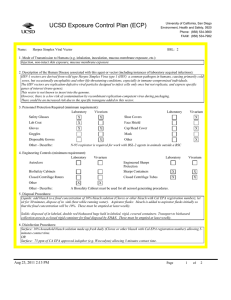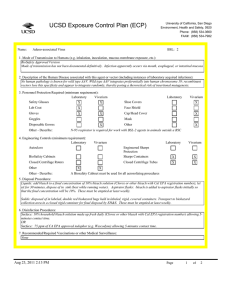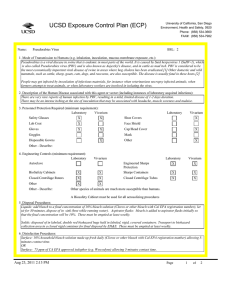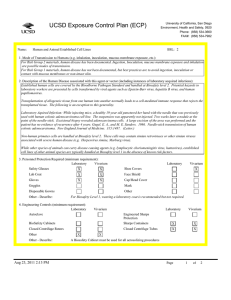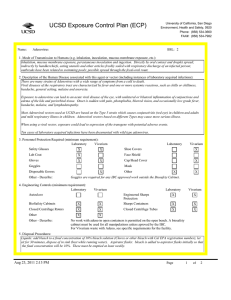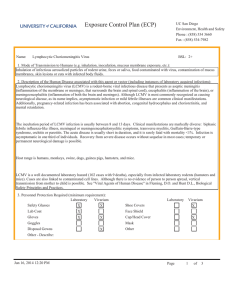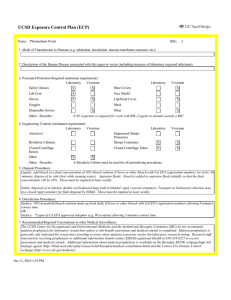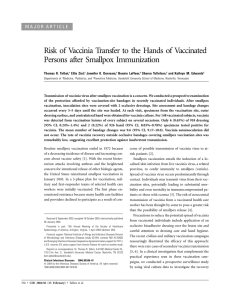Exposure Control Plan (ECP)
advertisement
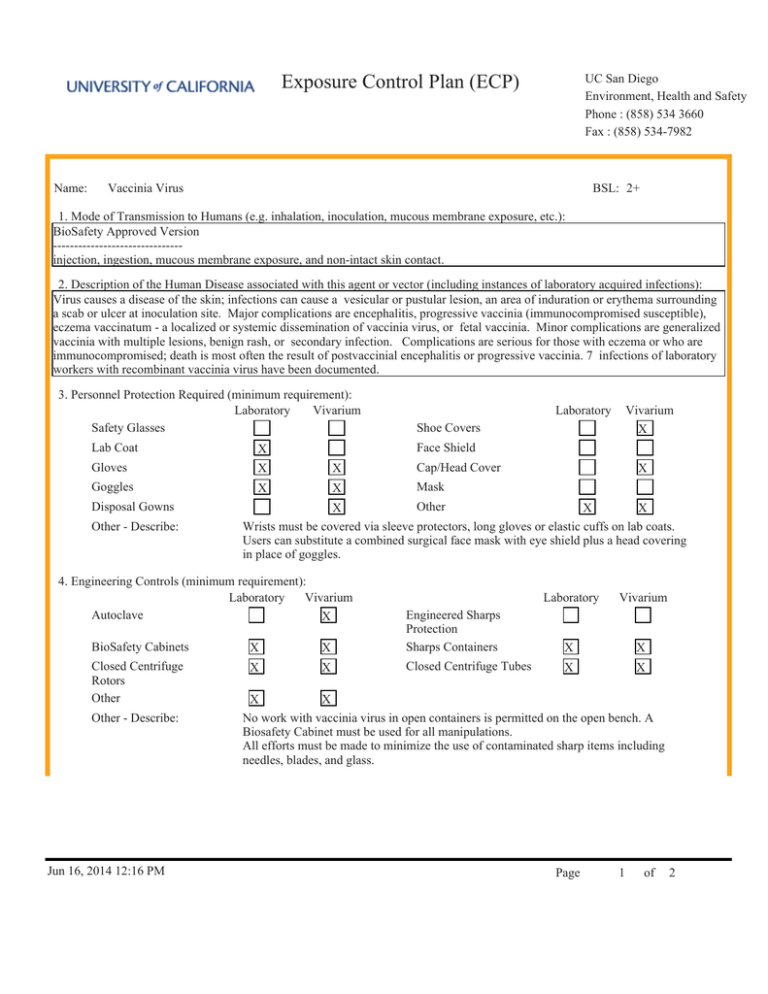
UC San Diego Environment, Health and Safety Phone : (858) 534 3660 Fax : (858) 534-7982 Exposure Control Plan (ECP) Name: Vaccinia Virus BSL: 2+ 1. Mode of Transmission to Humans (e.g. inhalation, inoculation, mucous membrane exposure, etc.): BioSafety Approved Version ------------------------------injection, ingestion, mucous membrane exposure, and non-intact skin contact. 2. Description of the Human Disease associated with this agent or vector (including instances of laboratory acquired infections): Virus causes a disease of the skin; infections can cause a vesicular or pustular lesion, an area of induration or erythema surrounding a scab or ulcer at inoculation site. Major complications are encephalitis, progressive vaccinia (immunocompromised susceptible), eczema vaccinatum - a localized or systemic dissemination of vaccinia virus, or fetal vaccinia. Minor complications are generalized vaccinia with multiple lesions, benign rash, or secondary infection. Complications are serious for those with eczema or who are immunocompromised; death is most often the result of postvaccinial encephalitis or progressive vaccinia. 7 infections of laboratory workers with recombinant vaccinia virus have been documented. 3. Personnel Protection Required (minimum requirement): Laboratory Vivarium Safety Glasses Lab Coat X Gloves X Goggles Disposal Gowns Other - Describe: Laboratory Shoe Covers Face Shield X X Cap/Head Cover X Mask BioSafety Cabinets X X Engineered Sharps Protection Sharps Containers Closed Centrifuge Rotors Other X X Closed Centrifuge Tubes Jun 16, 2014 12:16 PM X Other X X X Wrists must be covered via sleeve protectors, long gloves or elastic cuffs on lab coats. Users can substitute a combined surgical face mask with eye shield plus a head covering in place of goggles. 4. Engineering Controls (minimum requirement): Laboratory Vivarium Autoclave X Other - Describe: Vivarium X Laboratory Vivarium X X X X X X No work with vaccinia virus in open containers is permitted on the open bench. A Biosafety Cabinet must be used for all manipulations. All efforts must be made to minimize the use of contaminated sharp items including needles, blades, and glass. Page 1 of 2 Exposure Control Plan (ECP) 5. Disposal Procedures: Liquids: add bleach to a final concentration of 10% bleach solution (Clorox or other bleach with Cal EPA registration number), let sit for 30 minutes, dispose of in sink (best while running water). Aspirator flasks: bleach is added to aspirator flasks initially so that the final concentration will be 10%. These must be emptied at least weekly. Solids: disposed of in labeled, double red biohazard bags held in labeled, rigid, covered containers. Transport to biohazard collection area in a closed rigid container for final disposal by EH&S. These must be emptied at least weekly. 6. Disinfection Procedures: Surface: 10% household bleach solution made up fresh daily (Clorox or other bleach with Cal EPA registration number) allowing 5minutes contact time. OR Surface: 75 ppm of CA EPA approved iodophor (e.g. Wescodyne) allowing 5-minutes contact time. OR 0.05 % Sodium hypochlorite (1:100 bleach/water made fresh daily) allowing 5 minutes contact time 7. Recommended/Required Vaccinations or other Medical Surveillance: Those working with Vaccinia and additional personnel with risk of exposure must read the Campus Policy on Vaccinia Virus Vaccination (refer to EHS High Risk Biological Agent webpage) and obtain counseling from the EHS Occupational Health clinic. Vaccination Acceptance or Declination form must be signed after these steps are completed. 8. Employee Exposures- first aid procedures: a. Eye exposure from splash or aerosols - rinse a minimum of 15 minutes in eye wash or flush area with water. b. Skin exposure - wash area with soap and water for 15 minutes c. Needle stick and/or sharps exposure - wash wound area with soap and water for 15 minutes d. Contamination of clothing - remove the contaminated clothing and place in biohazard bag, shower with the emergency douse shower, and put on clean clothes. e. Spill or release - Monday through Friday, 8a - 4:30p call EH&S; after hours call Campus Police 9. Employee Exposure - seek medical follow-up from the following medical providers: (TAKE THIS ECP WITH YOU) 24-hour walk-in service: Hospital Emergency Room Or nearest Medical Center Emergency Room Call your campus Occupational Health contact to determine if a follow up visit is required. Most exposures will require a visit to Occupational Health. Monday - Friday, 8a - 4:30p 10. Report All Injuries, Illnesses, and Exposures to EH&S: Report the injury incident to their immediate supervisor and complete your campus injury report form 11. Required Biosafety Training: 1. EH&S Viral Vectors Safety Training is required. 2. Laboratory specific training on hazards, exposure evaluations, and the required precautions for experimental procedures used with this agent - provided by Principle Investigator 3. This ECP must be read and understood by all lab staff working in a lab where vaccinia is being used. 12. Lab specific instructions: Jun 16, 2014 12:16 PM Page 2 of 2
